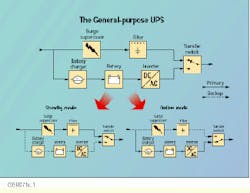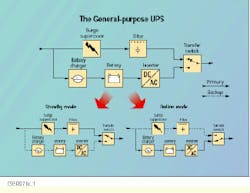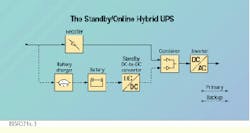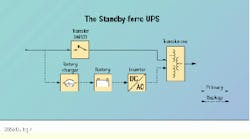Choose the UPS system that meets your needs
There are many types of UPS systems on the market today. It`s important to understand how the different devices operate as well as the strengths and weaknesses of each system.
Neil Rasmussen, American Power Conversion
It is widely believed that there are only two types of uninterruptible power supply (UPS) systems: the standby UPS and the online UPS. These two terms, as commonly understood, are not correctly applied to many UPS systems on the market today. Many misunderstandings about UPS systems are cleared up when the different types of UPS topologies are properly identified.
UPS systems are intended to improve the quality of AC power and to provide uninterrupted operation of AC-powered equipment. To accomplish these functions, a UPS takes in normal-quality AC power from the local electrical utility and provides two enhancements: power quality improvement and a redundant (or backup) power source.
Power-quality defects that may be improved by a UPS include surges, noise and sags. A UPS system also provides redundant power by supplying a backup power source in case the primary source fails. Backup power typically comes from a battery.
The general-purpose uninterruptible power supply may be operated as either a standby-type UPS or an online UPS. The main difference in operation is the power path chosen to be primary. For standby UPS operation, the transfer switch is set to select filtered AC input as the primary power source; it switches to the battery/inverter as the backup source in case of failure of the utility. For online operation, the transfer switch is set to select the battery/inverter as the primary source, and it switches to AC input as the backup source in case the battery/inverter fails. This distinction between online and standby UPS operation is very simple, but it gives rise to some important differences in operation.
For example, one interesting difference between standby and online operation of this type of UPS is the way it functions during a failure of input AC power. In standby operation, the transfer switch must transfer to the battery/inverter as the backup power source. However, in the case of online operation, failure of input AC does not activate the transfer switch, because input AC is not the primary power source (but is rather the backup source in this operational mode). Therefore, during an input AC power failure, online operation results in no transfer time when shifting to backup power.
The online mode of operation, on the other hand, exhibits a transfer time when the power from the primary battery charger/battery/inverter power path fails. This can occur when any of the devices in this power path fail. The power can also drop out briefly, causing a transfer, if the inverter is subjected to sudden changes in the load, or if the inverter experiences an internal control glitch.
So, actual online UPS systems do exhibit a transfer time, and in real-life installations may transfer as frequently as standby-type UPS systems. However, online UPS transfers are not related to AC input power failures, as they are with a standby UPS.
The size of the battery charger is greatly affected by the choice of standby versus online operation of the general-purpose UPS. When used in the online mode, the battery charger must be large enough to handle all of the output power to prevent the battery from discharging. When used in the standby mode, the battery need only supply the comparatively small recharging power required for itself.
The heat generated by an uninterruptible power supply is much greater when the general-purpose UPS is operated in the online mode. The flow of power through the battery charger and inverter causes a power loss of 25% to 30%. This power loss generates heat, which shortens the lifetime of the electrical components in the UPS and drastically reduces the life of the battery. (The negative impact on battery life is eliminated if the batteries are in a separate cabinet.)
When the UPS is operated in standby mode, the power loss of the filter and surge suppressor are an insignificant 1% to 2%. Over the lifetime of the UPS, the cost of the extra (and wasted) electricity required when the UPS is operated in the online mode will be a significant fraction of the original cost of the UPS itself.
UPS systems that have the classical online topology include some models from Sola and Toshiba. Units that take the classical standby approach include the APC Back-UPS and Emerson Accupower.
Other UPS topologies
Many UPS systems available today are not of the classical standby or online types. These systems use a variety of different approaches, which include:
- online without bypass
- standby/online hybrid
- standby-ferro
- line-interactive.
Many of these UPS types are improperly classified as either standby or online designs. Such improper classification leads to mistaken beliefs on the part of users regarding the levels of protection provided by the UPS.
Online without bypass--In this topology, the general-purpose UPS is set up to operate in the online mode, but the entire backup power path is removed.
When an online UPS does not have a bypass, the device does not provide a backup power source in case of power failure or a glitch in the primary source, the inverter. Therefore, one important characteristic of a UPS--redundancy--is not delivered by this type of UPS. This UPS does not exhibit a transfer time during a power failure, and for this reason is frequently portrayed as an online UPS.
Large UPS systems for minicomputers and mainframes are never of this type, but the lack of the backup power path, referred to as a bypass, is often unrecognized in the personal-computer market. Therefore, this type of UPS is sometimes sold in that marketplace.
Standby/online hybrid--The standby/online hybrid UPS is a modification of the online-without-bypass design. In this case, the battery charger and battery connections are modified, and a standby DC-to-DC converter is added.
The standby converter from the battery is switched on when an AC power failure is detected, just as is the case with a standby UPS. The battery charger is small, and this UPS will exhibit no transfer time during an AC power failure. However, like the online-without-bypass UPS, this unit has an inverter that is a possible single point of failure for which there is no backup power path.
The most misunderstood thing about this topology is the belief that the primary power path is always online. In fact, the power path from the battery to the output is only partly online; the inverter is online, while the DC-to-DC converter is operated in the standby mode.
Note that in this topology, unlike either the classical standby or online designs, there is no backup power path in case of failure of the primary power path. This topology is used in UPS systems such as the Unison Unipower and Exide`s Personal Powerware.
Standby-ferro--The standby-ferro UPS depends on a special transformer that has three windings (power connections). The primary power path is from AC input, through a transfer switch to the transformer, and then to the output. In case of a power failure, the transfer switch is opened, and the inverter picks up the output load.
In the standby-ferro design, the inverter is in the standby mode and is energized when the input power fails and the transfer switch is opened. The transformer has a special ferro-resonant capability that provides limited regulation and output waveform shaping. The isolation from AC power transients provided by the ferro transformer is as good as or better than that of any filter available, but the ferro transformer itself creates severe output voltage distortion and transients that can be worse than a faulty AC connection. Even though it is inherently a standby UPS, the standby-ferro generates a great deal of heat because the ferro-resonant transformer is inherently inefficient. The best-known example of this type of UPS is the Best FerrUPS.
Standby-ferro uninterruptible power supply systems are frequently represented as online units, even though they have a transfer switch, the inverter operates in the standby mode, and they exhibit a transfer time during an AC power failure.
Line-interactive--In this hybrid design, the battery-to-AC power converter (inverter) is always connected to the output of the UPS.
In the line-interactive UPS, battery charging is done by operating the inverter in reverse during times when the input AC power is normal. When the input power fails, the transfer switch opens and the power flow is from battery to UPS output.
The fact that the inverter is always connected to the output means additional filtering and reduced switching transients, compared to the standby-type UPS. The inverter also provides regulation, operating to correct brownout conditions that would otherwise force the UPS to switch to battery operation. This allows the UPS to operate at sites with poor power quality. The inverter can be designed so that its failure will still permit power flow from the AC input to the output, which eliminates the potential for a single-point failure and effectively provides for two independent power paths.
This topology is inherently very efficient, which leads to high reliability. At the same time, it also provides superior power protection. The APC Smart-UPS and Best Fortress are UPS systems of this type.
Other important UPS features
Isolation transformers may be incorporated into any type of UPS. Isolation transformers can be used to completely eliminate a type of AC line noise called common-mode noise. There is much confusion in the industry regarding common-mode noise, and the distinction between it and intersystem ground noise is not properly made in most advertising and other literature. Computer networks are susceptible to intersystem ground noise, but they are relatively immune to common-mode noise. Unfortunately, many users specify isolation transformers to solve intersystem ground noise problems, even though these devices have absolutely no effect on the problem. Most UPS systems today, whether online, standby or hybrid in design, use electronic filters to provide common-mode isolation. q
Neil Rasmussen is vice president of engineering at American Power Conversion`s research and design facility in Billerica, MA.
The general-purpose UPS can operate in either the online or the standby mode, depending on which is the primary power path and which the backup.
The online without bypass UPS operates with the backup power path removed. Instead, battery charger and battery are online, driving a DC-to-AC inverter.
The standby/online design is derived from the online without bypass topology, but the battery charger and battery connection are modified, and a standby DC-to-DC converter is added.
The standby-ferro UPS depends on a special transformer with three windings. When AC input power fails, a transfer switch is opened, and an inverter picks up the load.




